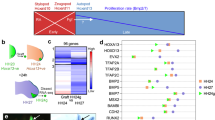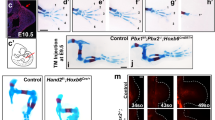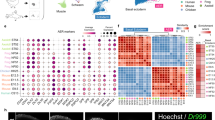Abstract
To determine the role of fibroblast growth factor (FGF) signalling from the apical ectodermal ridge (AER), we inactivated Fgf4 and Fgf8 in AER cells or their precursors at different stages of mouse limb development. We show that FGF4 and FGF8 regulate cell number in the nascent limb bud and are required for survival of cells located far from the AER. On the basis of the skeletal phenotypes observed, we conclude that these functions are essential to ensure that sufficient progenitor cells are available to form the normal complement of skeletal elements, and perhaps other limb tissues. In the complete absence of both FGF4 and FGF8 activities, limb development fails. We present a model to explain how the mutant phenotypes arise from FGF-mediated effects on limb bud size and cell survival.
This is a preview of subscription content, access via your institution
Access options
Subscribe to this journal
Receive 51 print issues and online access
$199.00 per year
only $3.90 per issue
Buy this article
- Purchase on Springer Link
- Instant access to full article PDF
Prices may be subject to local taxes which are calculated during checkout






Similar content being viewed by others
References
Hinchliffe, J. R. & Johnson, D. R. The Development of the Vertebrate Limb: An Approach Through Experiment, Genetics, and Evolution (Clarendon, Oxford, 1980)
Johnson, R. L. & Tabin, C. J. Molecular models for vertebrate limb development. Cell 90, 979–990 (1997)
Saunders, J. W. Jr The proximo-distal sequence of the origin of the parts of the chick wing and the role of the ectoderm. J. Exp. Zool. 108, 363–403 (1948)
Summerbell, D. A quantitative analysis of the effect of excision of the AER from the chick limb bud. J. Embryol. Exp. Morphol. 32, 651–660 (1974)
Rowe, D. A. & Fallon, J. F. The proximodistal determination of skeletal parts in the developing chick leg. J. Embryol. Exp. Morphol. 68, 1–7 (1982)
Rubin, L. & Saunders, J. W. J. Ectodermal-mesodermal interactions in the growth of limb buds in the chick embryo: constancy and temporal limits of the ectodermal induction. Dev. Biol. 28, 94–112 (1972)
Niswander, L., Tickle, C., Vogel, A., Booth, I. & Martin, G. R. FGF-4 replaces the apical ectodermal ridge and directs outgrowth and patterning of the limb. Cell 75, 579–587 (1993)
Fallon, J. et al. FGF-2: Apical ectodermal ridge growth signal for chick limb development. Science 264, 104–107 (1994)
Ornitz, D. M. & Itoh, N. Fibroblast growth factors. Genome Biol. 2, 3005.1–3005.12 (2001)
Martin, G. R. The roles of FGFs in the early development of vertebrate limbs. Genes Dev. 12, 1571–1586 (1998)
Sun, X. et al. Conditional inactivation of Fgf4 reveals complexity of signalling during limb bud development. Nature Genet. 25, 83–86 (2000)
Feldman, B., Poueymirou, W., Papaioannou, V. E., DeChiara, T. M. & Goldfarb, M. Requirement of FGF-4 for postimplantation mouse development. Science 267, 246–249 (1995)
Sun, X., Meyers, E. N., Lewandoski, M. & Martin, G. R. Targeted disruption of Fgf8 causes failure of cell migration in the gastrulating mouse embryo. Genes Dev. 13, 1834–1846 (1999)
Colvin, J. S., Green, R. P., Schmahl, J., Capel, B. & Ornitz, D. M. Male-to-female sex reversal in mice lacking fibroblast growth factor 9. Cell 104, 875–889 (2001)
Xu, J., Liu, Z. & Ornitz, D. M. Temporal and spatial gradients of Fgf8 and Fgf17 regulate proliferation and differentiation of midline cerebellar structures. Development 127, 1833–1843 (2000)
Moon, A. M., Boulet, A. M. & Capecchi, M. R. Normal limb development in conditional mutants of Fgf4. Development 127, 989–996 (2000)
Lewandoski, M., Sun, X. & Martin, G. R. Fgf8 signalling from the AER is essential for normal limb development. Nature Genet. 26, 460–463 (2000)
Moon, A. M. & Capecchi, M. R. Fgf8 is required for outgrowth and patterning of the limbs. Nature Genet. 26, 455–459 (2000)
Meyers, E. N., Lewandoski, M. & Martin, G. R. An Fgf8 mutant allelic series generated by Cre- and Flp-mediated recombination. Nature Genet. 18, 136–141 (1998)
Wright, E. et al. The Sry-related gene Sox9 is expressed during chondrogenesis in mouse embryos. Nature Genet. 9, 15–20 (1995)
Min, H. et al. Fgf-10 is required for both limb and lung development and exhibits striking functional similarity to Drosophila branchless. Genes Dev. 12, 3156–3161 (1998)
Sekine, K. et al. Fgf10 is essential for limb and lung formation. Nature Genet. 21, 138–141 (1999)
Revest, J. M. et al. Fibroblast growth factor receptor 2-IIIb acts upstream of Shh and Fgf4 and is required for limb bud maintenance but not for the induction of Fgf8, Fgf10, Msx1, or Bmp4. Dev. Biol. 231, 47–62 (2001)
Prahlad, K. V., Skala, G., Jones, D. G. & Briles, W. E. Limbless: a new genetic mutant in the chick. J. Exp. Zool. 209, 427–434 (1979)
Takahashi, M. et al. The role of Alx-4 in the establishment of anteroposterior polarity during vertebrate limb development. Development 125, 4417–4425 (1998)
Rowe, D. A., Cairns, J. M. & Fallon, J. F. Spatial and temporal patterns of cell death in limb bud mesoderm after apical ectodermal ridge removal. Dev. Biol. 93, 83–91 (1982)
Dudley, A. T., Ros, M. A. & Tabin, C. J. A re-examination of proximodistal patterning during vertebrate limb development. Nature 418, 539–544 (2002)
Bober, E., Franz, T., Arnold, H. H., Gruss, P. & Tremblay, P. Pax-3 is required for the development of limb muscles: a possible role for the migration of dermomyotomal muscle progenitor cells. Development 120, 603–612 (1994)
Baldwin, H. S. et al. Platelet endothelial cell adhesion molecule-1 (PECAM-1/CD31): alternatively spliced, functionally distinct isoforms expressed during mammalian cardiovascular development. Development 120, 2539–2553 (1994)
Gurley, L. R., D'Anna, J. A., Barham, S. S., Deaven, L. L. & Tobey, R. A. Histone phosphorylation and chromatin structure during mitosis in Chinese hamster cells. Eur. J. Biochem. 84, 1–15 (1978)
Hornbruch, A. & Wolpert, L. Cell division in the early growth and morphogenesis of the chick limb. Nature 226, 764–766 (1970)
Chiang, C. et al. Manifestation of the limb prepattern: limb development in the absence of Sonic hedgehog function. Dev. Biol. 236, 421–435 (2001)
Kraus, P., Fraidenraich, D. & Loomis, C. A. Some distal limb structures develop in mice lacking Sonic hedgehog signalling. Mech. Dev. 100, 45–58 (2001)
Alberch, P. & Gale, E. A. Size dependence during the development of the amphibian foot. Colchicine-induced digital loss and reduction. J. Embryol. Exp. Morphol. 76, 177–197 (1983)
Wolpert, L., Tickle, C. & Sampford, M. The effect of cell killing by X-irradiation on pattern formation in the chick limb. J. Embryol. Exp. Morphol. 50, 175–193 (1979)
Li, S. & Muneoka, K. Cell migration and chick limb development: chemotactic action of FGF-4 and the AER. Dev. Biol. 211, 335–347 (1999)
Saxton, T. M. et al. The SH2 tyrosine phosphatase Shp2 is required for mammalian limb development. Nature Genet. 24, 420–423 (2000)
Stark, R. J. & Searls, R. L. The establishment of the cartilage pattern in the embryonic chick wing, and evidence for a role of the dorsal and ventral ectoderm in normal wing development. Dev. Biol. 38, 51–63 (1974)
Summerbell, D., Lewis, J. H. & Wolpert, L. Positional information in chick limb morphogenesis. Nature 244, 492–496 (1973)
Capdevila, J., Tsukui, T., Rodriquez Esteban, C., Zappavigna, V. & Izpisua Belmonte, J. C. Control of vertebrate limb outgrowth by the proximal factor Meis2 and distal antagonism of BMPs by Gremlin. Mol. Cell 4, 839–849 (1999)
Mercader, N. et al. Conserved regulation of proximodistal limb axis development by Meis1/Hth. Nature 402, 425–429 (1999)
Mercader, N. et al. Opposing RA and FGF signals control proximodistal vertebrate limb development through regulation of Meis genes. Development 127, 3961–3970 (2000)
Maini, P. K. & Solursh, M. Cellular mechanisms of pattern formation in the developing limb. Int. Rev. Cytol. 129, 91–133 (1991)
Dahn, R. D. & Fallon, J. F. Interdigital regulation of digit identity and homeotic transformation by modulated BMP signalling. Science 289, 438–441 (2000)
Kingsley, D. M. Genetic control of bone and joint formation. Novartis Found. Symp. 232, 213–222 (2001)
Muneoka, K., Wanek, N. & Bryant, S. V. Mammalian limb bud development: in situ fate maps of early hindlimb buds. J. Exp. Zool. 249, 50–54 (1989)
Carter, T. The genetics of luxate mice. IV. Embryology. J. Gent. 52, 1–35 (1954)
Vargesson, N. et al. Cell fate in the chick limb bud and relationship to gene expression. Development 124, 1909–1918 (1997)
Acknowledgements
We thank M. Lewandoski, whose studies on the phenotype of Fgf8 single mutant embryos first suggested the model of AER-FGF function described here, for discussion at the outset of this work. We are grateful to J. Fallon, D. Kingsley and C. Tickle for discussion, and C. Tabin and A. Dudley for sharing unpublished information and helpful comments. We also thank D. Duboule, P. Gruss, R. Harland, B. Hogan, N. Itoh, J.-C. Izpisua-Belmonte, V. Lefebvre, A. McMahon, D. Ornitz, P. Sharpe, M. Scott and R. Wisdom for providing plasmids from which probes were prepared; D. Lakeland for help with statistical analysis; C. Larabell for technical advice on confocal microscopy; C. Petersen, Z. Serrano, J. Watanabe and R. Rantala for technical assistance; and H. Ingraham, J. Saunders, G. Schubiger and our colleagues in the Martin laboratory for comments on the manuscript. X.S. was the recipient of a postdoctoral fellowship from the American Cancer Society and was supported by an NIH Training grant. F.M. is the recipient of an individual National Research Service Award from the NIH. This work was supported by an HHMI Research Resources Program grant to the UCSF School of Medicine, and an NIH grant to G.R.M.
Author information
Authors and Affiliations
Corresponding author
Ethics declarations
Competing interests
The authors declare that they have no competing financial interests.
Rights and permissions
About this article
Cite this article
Sun, X., Mariani, F. & Martin, G. Functions of FGF signalling from the apical ectodermal ridge in limb development. Nature 418, 501–508 (2002). https://doi.org/10.1038/nature00902
Received:
Accepted:
Issue Date:
DOI: https://doi.org/10.1038/nature00902
This article is cited by
-
Fgf signalling triggers an intrinsic mesodermal timer that determines the duration of limb patterning
Nature Communications (2023)
-
Generation of extracellular morphogen gradients: the case for diffusion
Nature Reviews Genetics (2021)
-
Gene expression in regenerating and scarring tails of lizard evidences three main key genes (wnt2b, egfl6, and arhgap28) activated during the regulated process of tail regeneration
Protoplasma (2021)
-
Radial glia fibers translate Fgf8 morphogenetic signals to generate a thalamic nuclear complex protomap in the mantle layer
Brain Structure and Function (2019)
-
An essential role for the nuclear protein Akirin2 in mouse limb interdigital tissue regression
Scientific Reports (2018)
Comments
By submitting a comment you agree to abide by our Terms and Community Guidelines. If you find something abusive or that does not comply with our terms or guidelines please flag it as inappropriate.



